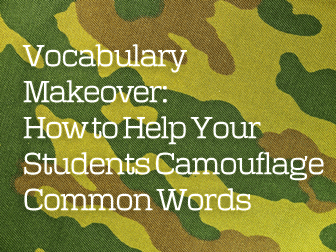Vocabulary Makeover: How to Help Your Students Camouflage Common Words


When they expand their vocabulary? When their lexicon is growing and growing? I know I do. I get so excited when a student uses English words that don’t often come up in the standard ESL vocabulary lists. It doesn’t happen without a little effort, though. Whether it comes from my students themselves or I supply it for the class, learning new words takes determination. Over the years, I have found several tricks for helping students expand their vocabularies. And they don’t take a lot of effort on my part, but the payoffs are great. Here are some of my favorites.
Do you know what I mean by word families? While many of the vocabulary units I teach may come designed around a theme with words that naturally go together, that’s not what I mean by a word family. What I mean is several words with the same or similar meaning. Synonyms if you will. Think of it this way. You look up the word understand in a thesaurus. Listed next to it are comprehend, know, recognize, realize, apprehend, cognize, and fathom. When you teach word families, you teach all of these words at the same time. Yes, it’s worth taking some time to differentiate each and explain their nuances and English only dictionaries are a must, but when students learn all of these words at once they are more likely to use more of them more often. They will choose a more specific word rather than a general one that could mean several different things.
Your students will have fun with this one. Ask them which English words are boring. They’ll tell you. Make a list on a bulletin board or poster in your room and then tell them these words are banned. They are no longer allowed to use them. Help them out, though, by giving them other options they can use instead of these boring words, and post those, too. (Get out that handy thesaurus again.) When they cannot use a simple, go-to, aka boring word, they will choose other more interesting and specific words in place of it and therefore develop and expand their vocabularies.
While you are at it, make your students a list of words they should use and make copies for each student. Give them a page of words that are character traits and words to describe a person. Give them a list of words that describe how something feels, smells, tastes, looks, or sounds. Put together other ways to say said, go, thing, and other words you want them to avoid. I have given lists like these to my students who used them well past my English class. If you don’t feel up to writing your own lists, there are plenty that others have put together. Try getting yourself a copy of Banish Boring Words by Leilen Shelton or looking up word lists online.
You even if you didn’t know the meaning of read, you might guess that a reader is a person who does it. That’s because of the content suffix –er which means a person who does. You know that words starting with anti- mean against something. And you can probably guess that unhappy means not happy just from the prefix un-. These are what I call content affixes – prefixes and suffixes that contain meaning. Other affixes are functional, they change a verb to a noun or make other similar part of speech changes (such as –ly which changes an adj. to an adv.). Content affixes change the meaning of a word or expand it. If you teach content affixes to your students, you give them the tools to both understand and create words and that will expand their vocabularies.
This is one of the easiest ways to encourage your students to take ownership of their own learning. Encourage them to keep one or more lists of words. I like my students to have a vocabulary notebook, and we do lots of different activities in it including developing our own word lists. I have students designate a page for new and unfamiliar words, and I encourage them to add words to their lists when they hear them in public, on television, or other places. I also have them label a page interesting words, and I have one in my notebook, too. On that page we list words we just like for whatever reason, words that we want to use and learn. My list includes onomatopoeia, ennui, and brisk for no other reason than I like them. Each person’s list will be different, but you can encourage students to add the members of their lists to a bulletin board (in letters large enough that your entire class can read them). Then other students might look these words up and add them to their own lists.
How specific are the words you use? How specific are those of your students? Often a bland vocabulary is one overrun with general words rather than specific ones. Encourage your class to use specific rather than general words. You can help them with this three column exercise. In the first column, list a general word like sound or fruit. In the second column, list a more specific word such as lullaby or apple. In the third column, get even more specific with words such as Brahms’s Lullaby or granny smith apple. Then challenge your students to use words from the third column when they speak or write rather than words from the first two.
You know that the words you use in your speech will naturally find their way into your students’ speech. So when you talk, use interesting words yourself. Don’t dumb down your language with the goal of being easy to understand. Yes your students might understand you better, but they also won’t get the exposure to interesting language that will benefit them more in the long run. You are the greatest example of English that your students have. Don’t waste your opportunity.
You can use these tricks to help your students expand their lexicons, but more than anything you have to show them that you find an extensive vocabulary valuable and that it’s worth it to you and to them to continually develop it.